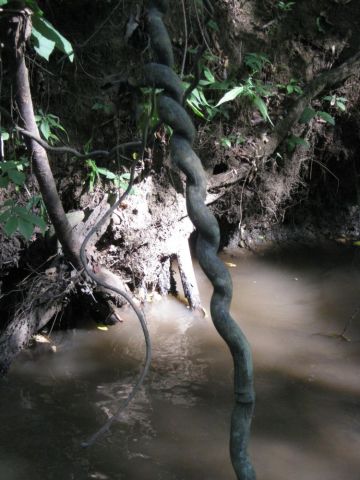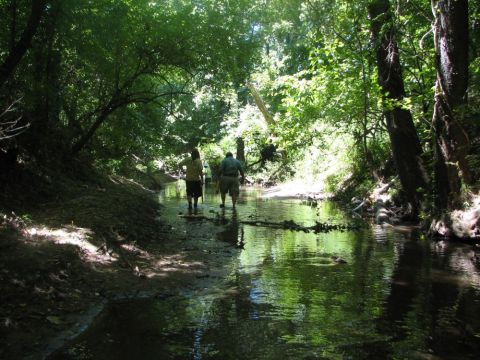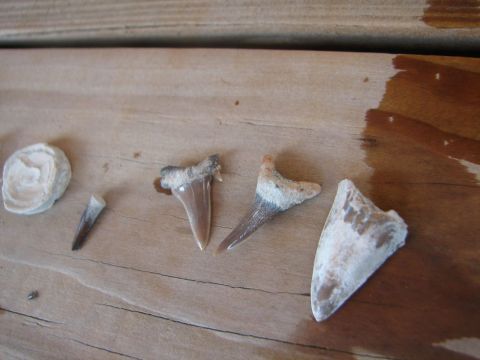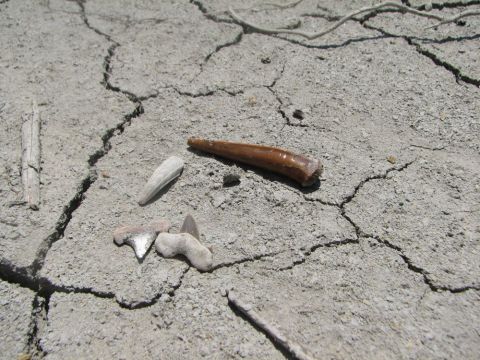View of the gully. These gullies are huge!
Visitor
cephalopod
July 31, 2010 - Cretaceous Fossils, Dallas and Perry Co, AL
BPS members defied the extreme heat and went to south Alabama to assist in collecting fossils and close down the dig site until the weather cools off some. A number of mosasaur bones were found, and a mosasaur jaw still containing a tooth. Other fossils found included shark teeth, shark vertebra, various varieties of fish, turtle bone, and enchodus jaw and teeth. The thermometer read 110 degrees, so after lunch under a covered pavilion, we headed to a nearby creek to cool down. The creek yielded numerous shark teeth, brachiopods, and a few cephalopod pieces.
Excavating a mosasaur jaw bone. Several members carefully sifted the chalk down the gully from the main excavation, finding several vertebra.
Fish vertebra, enchodus tooth and several shark teeth found in the gullies. Notice the whiteness of one of the shark teeth - many have deteriorated under the hot sun.
The long pointy tooth is an Enchodus tooth, and the others are shark teeth
- 1 of 2
- next ›
February 27, 2010 - Mississippian Fossils, Colbert and Franklin Co, AL
There must have been a lot of people concerned about the weather report, which predicted snow and ice in North Alabama. Only 5 of us showed up, but what a wonderful day it turned out to be. It stayed cold in Birmingham, but the weather at the collecting sites warmed up to the 50's, and Don remarked we better tell the field trip planner thanks for picking such a great day! The smaller number of people meant we could stay at each location longer, and it really paid off. We found numerous crinoid stems, several varieties of blastoids, part of a straight cephalopod, brachiopods of all sizes, trilobites, and lots of horned coral.
- 1 of 2
- next ›
07_11_vl_shells996
Brachiopod impressions and what appear to be straight cephalopod impressions.
07_11_vl_shells063
A mass of brachiopods and what appear to be small straight cephalopods.
February 17, 2007 - Mississippian Fossils, Franklin Co, AL
Once again, the word, "intrepid" comes to mind when BPS makes a midwinter trip! With the temps in the upper 30's and low 40's and 15-20 mph winds, it was a toss up as to which trip to this site was the coldest! In spite of the weather, around 23 fossil seekers came for the fun. Our first stop was under sunny skys and slight winds which brought the temperature up to a bearable level. This is a great site, featuring a prehistoric coral reef that always has excellent specimens washed out during the previous year. It's always a temptation go after the big boulders, but they're much larger than they look (like iceburgs) so we can only stand and drool and capture them on camera. At the first stop on the lake numerous specimens of blastoids, archimedes, and crinoid stems were found, and a very nice piece of petrified/ permineralized wood. Next we went to the other side of the lake where it was downright windy and bitter cold. More crinoid stems, straight cephalapods, and some unknown specimens were collected as well as great slabs of fossil hash. These make great teaching tools as well as attractive showpieces. We were also treated to the sight of Bill "walking on water!" Next we stopped at a roadcut which yielded a few more nice specimens, and a lot more icy wind. After one last site check, hunger was the issue, so most of the group organized to follow Greg, who always seems to know the best places to chow down, to a long enjoyable evening meal at a "secret" local steak house, After a great time of good food, rehashing the day and catching up, tired BPS members headed home.
--Edited by Vicki Lais
(Photos courtesy Jan Novak, Bill Fowler, Chris Lais, & Vicki Lais)




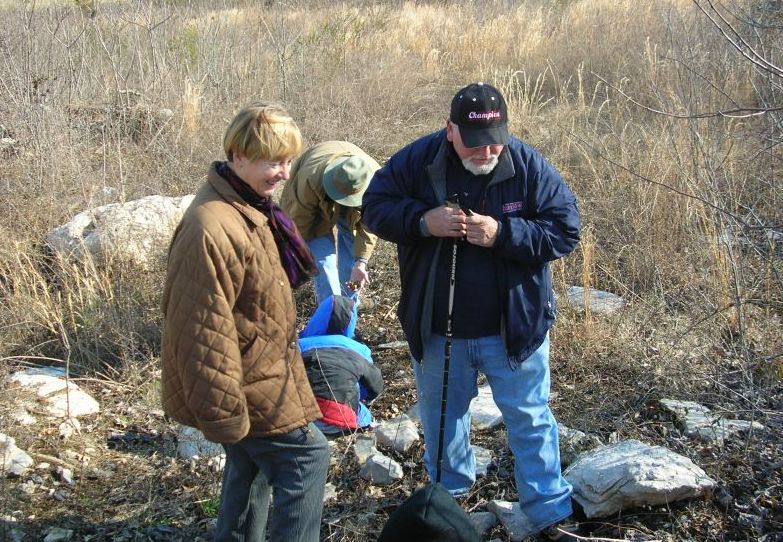





On to the next stop, where we were given an overview of the collecting area.

Shoreline of the lake, water is way down in winter.

Horned coral.

A sponge?

Horned coral.

Nice brachiopod.

Most rocks in the area consist of numerous small fragments of fossils. Most visible on this specimen are crinoid stems and bryozoan (or the netting material from archimedes.)

Parts of very large, but broken, blastiods.
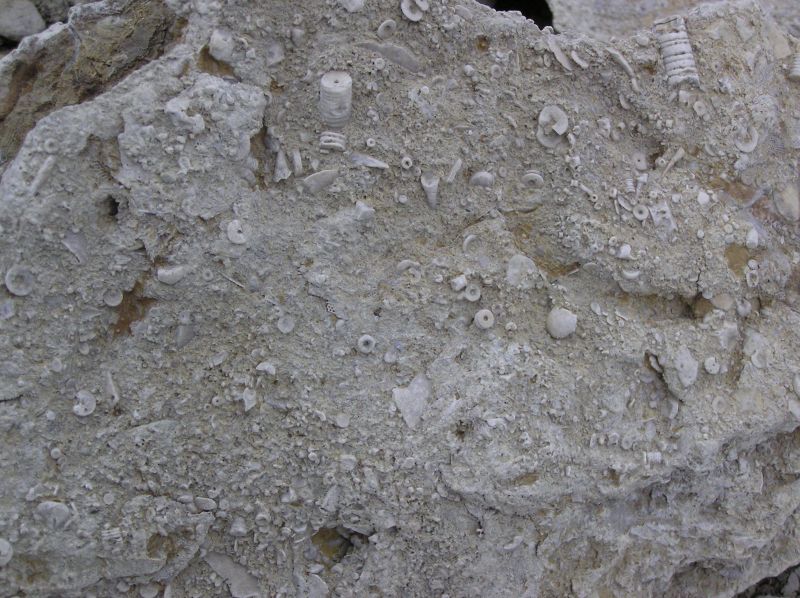

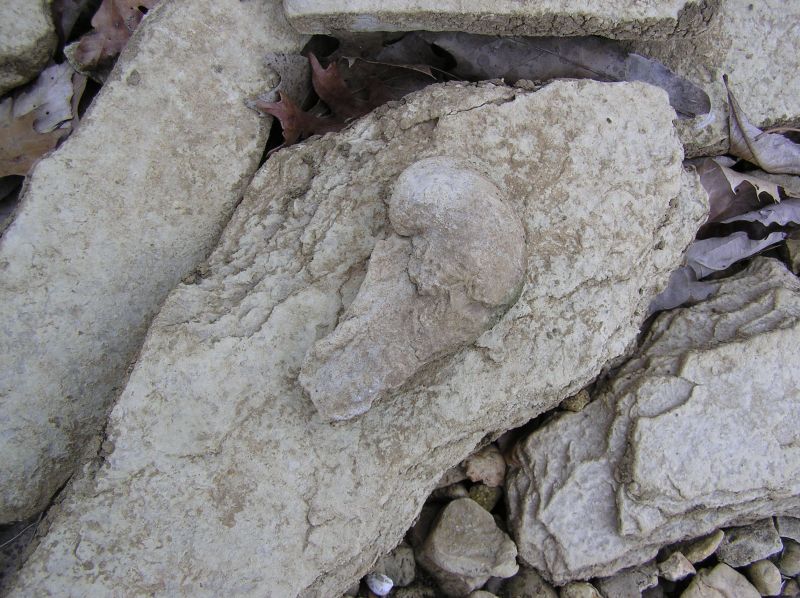
Tiny gastropod.


Unknown round fossil.


Another unknown fossil.

Very nice specimen of petrified/permineralized wood.

How'd he do that?? Bill has found several nice specimens. Click, then click again for larger image.

Nice cephalopod.

Brachiopods.


After the lake, we collected at a nearby roadcut.

Numerous specimens of burrow casts were found, and also a few straight cephalopod's (in middle).

At the last stop of the day, geologic layering is very prominent.


Tall people have a distinct advantage!
December 2, 2006 - Mississippian Fossils, St. Clair Co, AL
--Edited by Vicki Lais
(Photos courtesy Becky Guthrie and Vicki Lais)
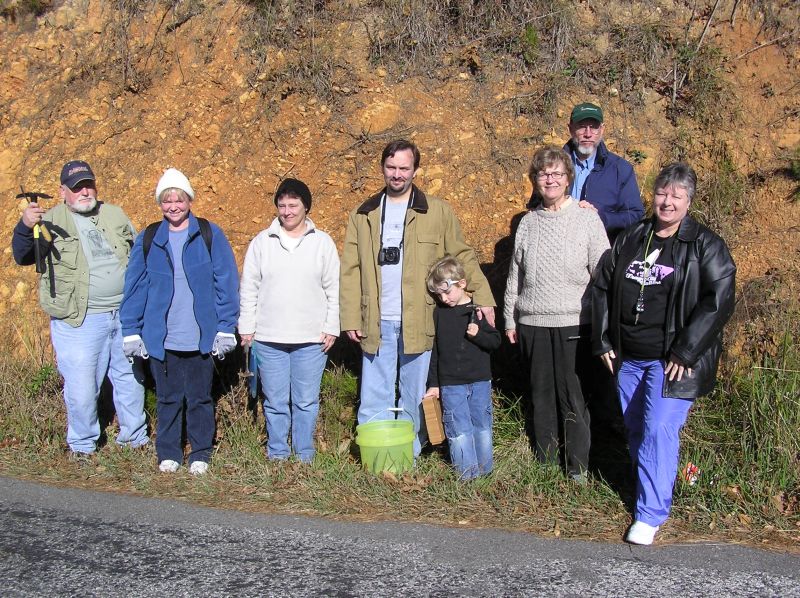


The most common fossil at this location is coral.

Crinoids are also found.

Greg shows Nathan how to crack the rocks to find the fossils inside.

Nice bryozoan impression and actual fossil remains.
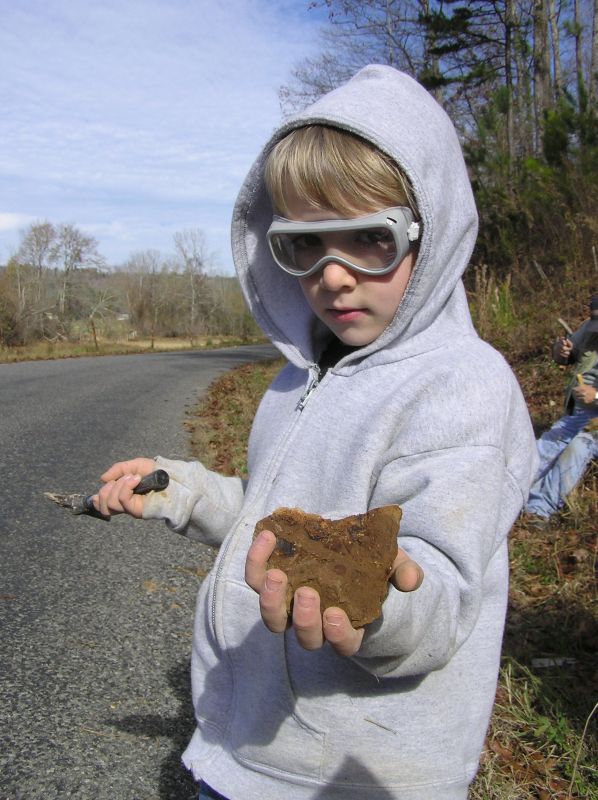
Nathan has found fossil brachiopods. Click picture for closer view.

An interesting piece of horned coral, laying loose in a hollow shaped like it. This specimen has obviously been weathering in this same location for many years.

Another view of the horned coral.

Becky also has a nice slab of brachiopods.

A closer look at Becky's slab.


Nice sponge; at higher resolution, the pores are easily visible.

More brachiopods.

And here's what we were hoping to find - trilobites!




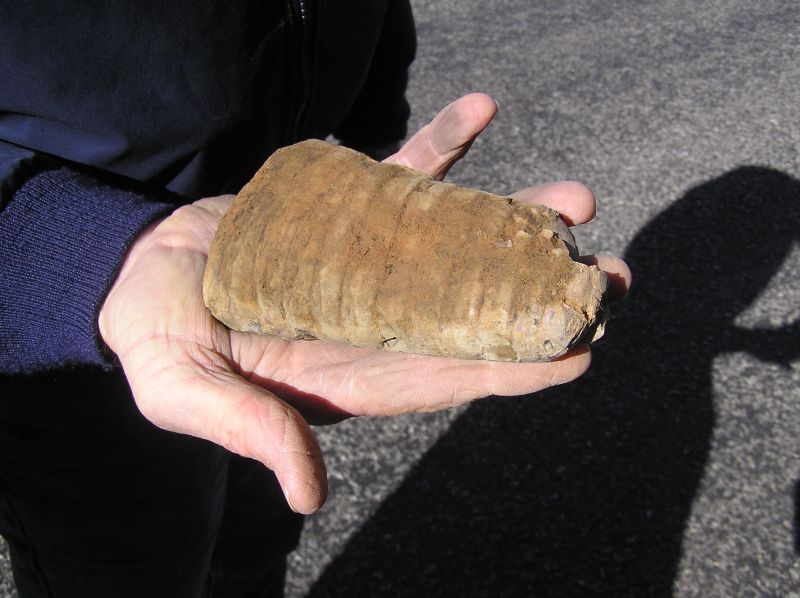
As nice as the trilobites are, this straight cephalopod was the find of the day!
December 3, 2005 - Lawrence, Franklin and Colbert Co, AL
Back in the car headed to site #2, and it began raining again. Darn! As the drizzle quits, someone suggests a side trip to the lake, to check the water level, and much to our delight, it was way down, so we added an unexpected new stop, where everyone found a number of crinoid stems, blastoids, archimedes, an unknown trace fossil, and horned coral. One comment was "How many days do we get to spend here?". The weather got warmer, and became very pleasant, even without coats (a real thrill to those of us who remember many collecting trips tolerating the icy cold wind that normally whips around the point most of the winter). In keeping with our international flavor, two guests from Japan (who have only been in the US since July) joined us for their first ever-fossil trip. We may have spoiled them. NO you DON'T find fossils on every spot of ground in Alabama!
Then, when Greg was able to tear us away from the lake, on to the next location, site #3, a popular road cut in Colbert County, where nice blastoids, archimedes, and straight cephalopods were found. Also, an outstanding question was answered. On our August 2005 field trip, an odd, lightweight, heart shaped disk was found in Montgomery County that we couldn't identify. On one of Vicki's side excursions today, she found part of a vertebra column, probably of a deer, and several of the heart-shaped cartilage discs were found in place. Now we know - not a fossil, but very interesting.
The 4th stop had a few specimens, but not enough to linger.
At that point, part of the group went to an additional site, where there were nice fossils, mostly still in matrix. This site contains metallic, cubic mineral specimens that have not yet been positively identified. They look similar to pyrite, but are the wrong shape and color. They are small, about 1/4 inch, cubic, shiny reddish-gold copper colored, and heavy for their size. The square sides aren't exactly straight, since they have a dip in the middle. They could possibly be limonite after pyrite.
After that, the entire group met up again, and headed to an off-the-beaten-path steak house in the middle of nowhere to wind down for the evening and enjoy each other's good company before starting the long trip back home.
(photos courtesy Lea Martin and Vicki Lais)
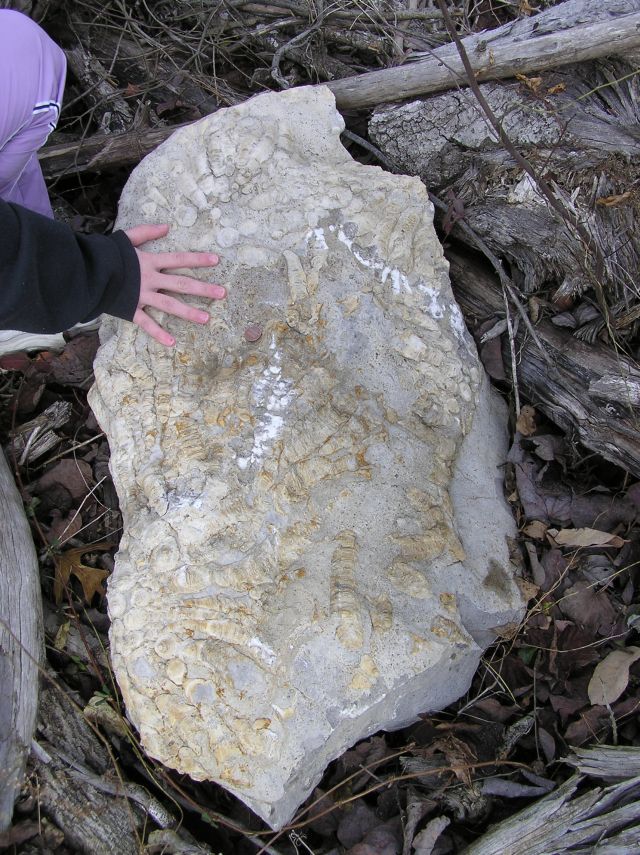
The first stop produced very large specimens of rugose coral, most too large to carry.

Leisa, our Pres, and new members Hitoshi and Yakari on their first fossil trip... Welcome to Alabama!

Paige just needs her picture taken since she is so photogenic. What a nice specimen of coral she's found!

Jan and Greg searching for loose corals.

One of the nicest specimens.
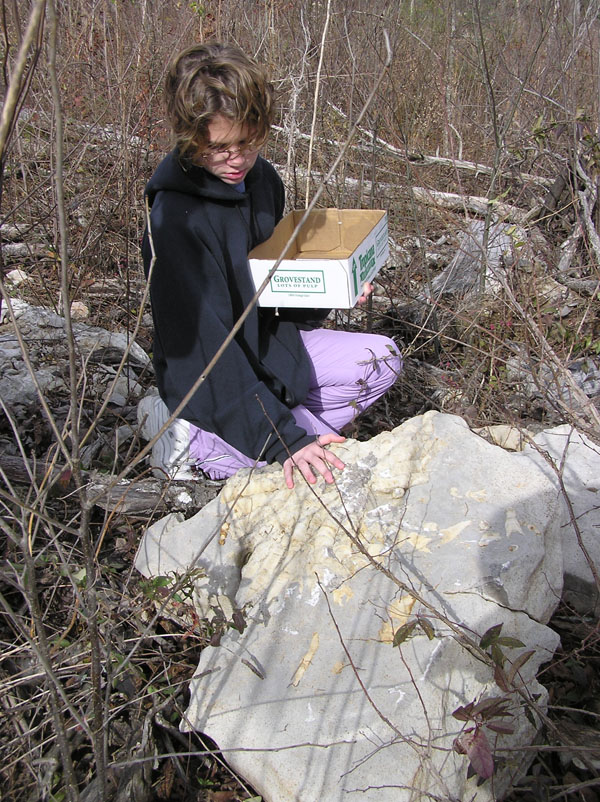
Uh.... Paige..... I don't think it will fit in your box......


Lea Novak has lugged this large coral to her car.
On to site #2 -

Most of the rocks on this lakeshore are filled with small fossils. Most plentiful are crinoids, blastoids, archimedes, and horned corals.
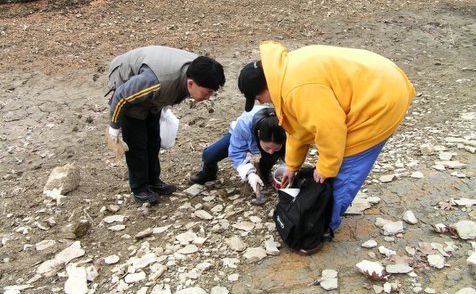
Leisa showing our newest members fossil specimens on the rocks.

Greg has found a nice slab to show how plentiful fossils are in this area.

Every rock here is covered with fossils. So why search? Some rocks have weathered more than others, and the fossils are in nice relief. Some have more "perfect" examples, some have more of the "pretty" fossils, or displayed a larger variety.


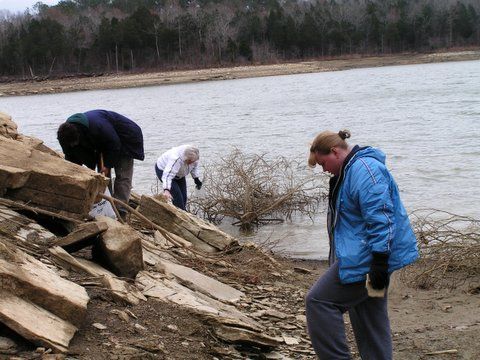
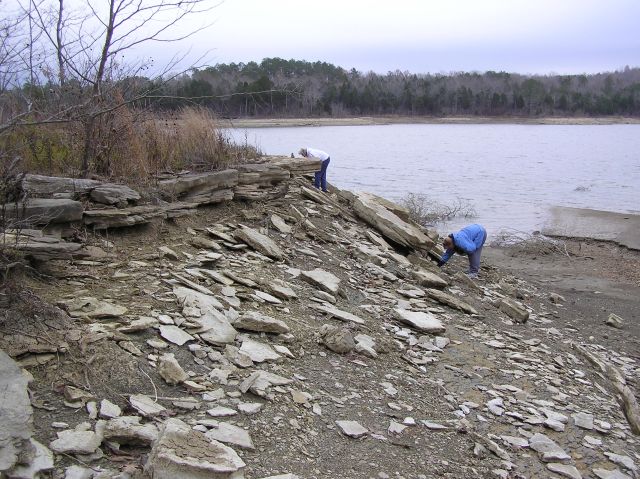

Melanie has found a nice.... well....umm.... trace fossil??
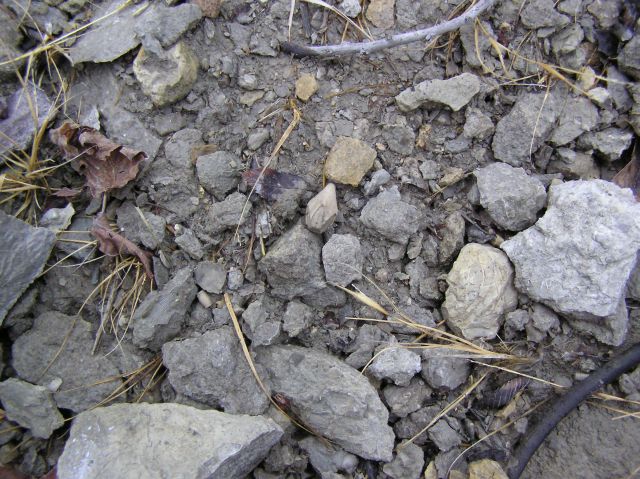
Look carefully in the middle of the photograph to see a blastoid.

Closer view of blastoids.

Hi, Claire!

Hard to see, but this boulder is covered with very tiny crinoids, probably a breeding area.
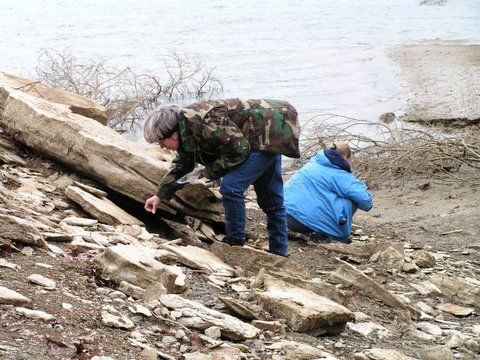
Stop #3 is a roadcut -
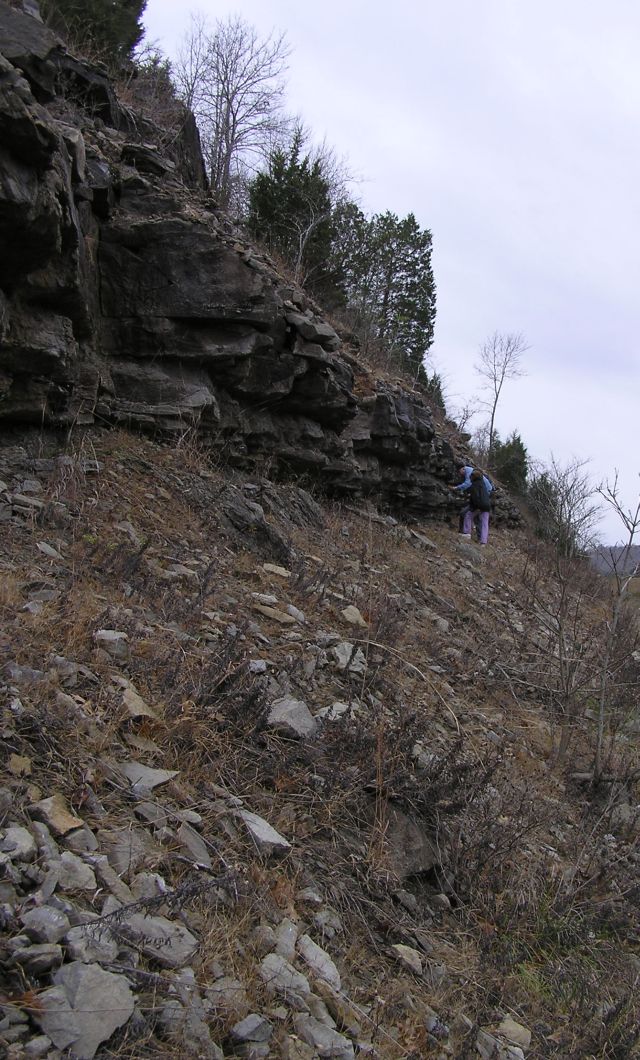
Blastoids, horned coral, and archimedes were found in this area.


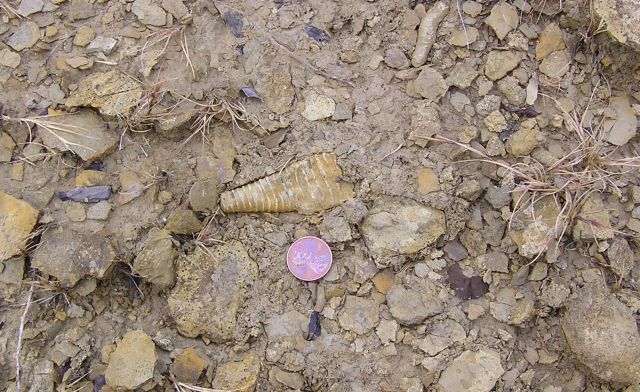
A few straight cephalopods were also found.
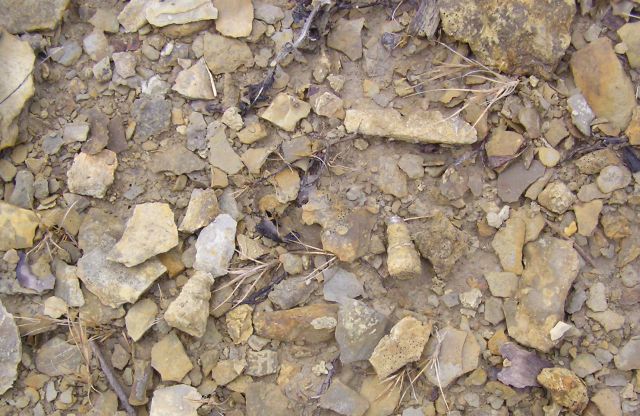
Some fairly worn specimens of horned coral.
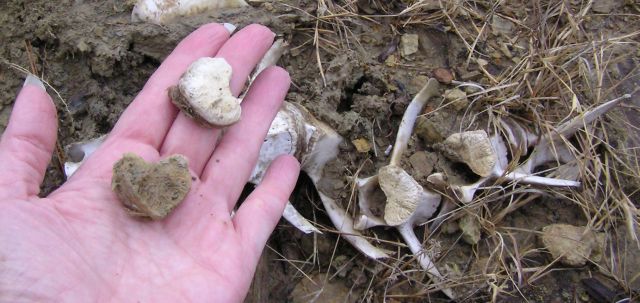
Another mystery solved. A heart shaped item had been found on our Montgomery trip, but no one knew what it was. Several of them were found in place today - in a deer spine. They are the discs between vertebra.
Stop #4 - another wash in a roadcut.

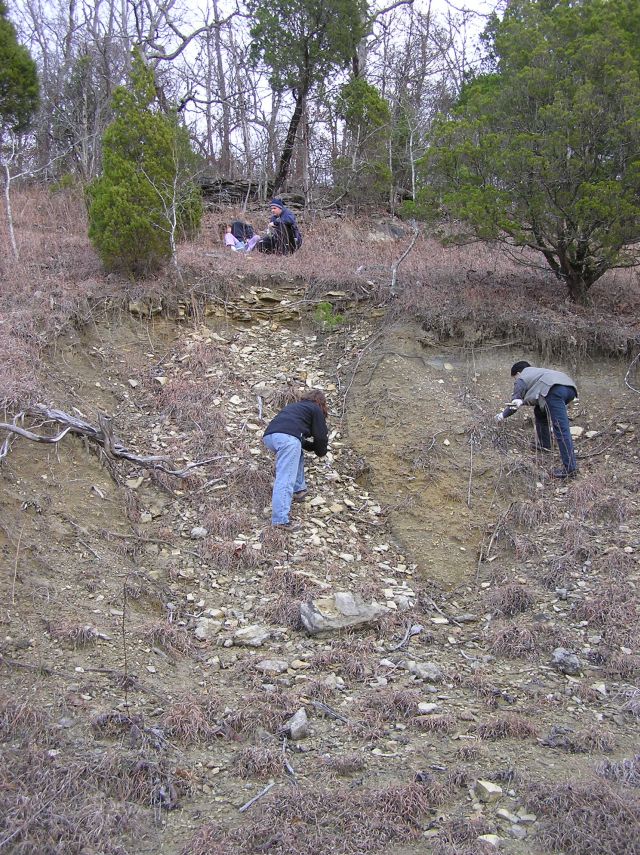
Very little was found at this location, but we had fun looking!
While most of the group headed for the local watering hole, 3 members proceeded on to stop #5:

A beautiful layer of bivalves is now exposed. Impossible to collect without damaging the specimens, so we collected only photos.

A closer view after cleaning. They are heavy, and may be pyrite. Possibly limonite after pyrite.
November 2, 2005 - Cretaceous Fossils, Sumter Co, AL
BPS members went down to the Tombigbee in search of specimens from the marl limestone sequences in the Arcola Limestone Member (Late Cretaceous Campanian 83-74 mya). Steve and Bobby furnished the boats. BPS members climbed aboard and we headed off down the river. This is one of our favorite spots so anticipation was high. Once arrived, we headed off in different directions, some going down to the far end of the beach in hopes of finding a large ammonite like the one found last trip.
The water was very low on this trip, exposing areas we had never collected. Another mosasaur bone, probably from our “pet” Mosasaur, “Bigbee” was unearthed, much to our pleasure. Numerous pieces of carboniferous wood were found, also worm tubes, gastropods and a very nice portion of a turtle, which was jacketed for prep work back home. Several shark teeth, straight cephalopod segments, and some fish teeth were also found.
We had very pleasant weather, and, after a full day of collecting, some wanted to settle in for some food and conversation while another part of the group decided to head down the river to a marcasite collecting area . Some very nice crystalline calcite specimens were found, in addition to the large quantity of marcasite. Much to our delight, it turns out that we had a marcasite specialist amongst us who gave us an impromptu lecture on marcasite characteristics. This inspired discussion of the possibility of forming a coprolite committee. Any volunteers? Anybody want to explain to the general public exactly what coprolite IS? Or was.
As it was getting too dark to see, it was decided that food and conversation seemed like a pretty good idea at this point, so we caught up with the others and finished off the day in great style.
Great trip, great weather, great group, great food.
--Edited by Vicki Lais
(Photos courtesy Anca Croitoru, Lea Novack, and Vicki Lais)

Reconnaissance session covering the geology of the area and sample specimens.

This is an excellent specimen of a fish jaw that Greg found on a previous trip.

Gastropods and straight cephalopods found on prior trips.

Lining up the boats.

On the way again. . . .


Rocky bluffs composed of Arcola Limestone. Very fossiliferous.

More views of the river.


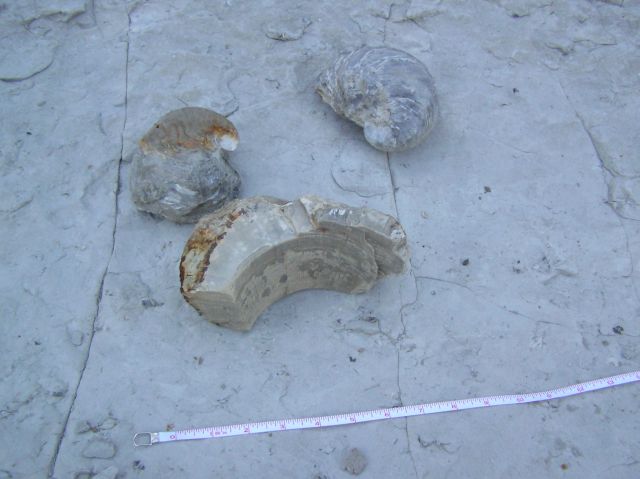
Large piece of shell and exogira.

Miscellaneous shells and straight cephalopods.

Numerous shell pieces in the limestone.

Anca beginning her search.

Loni found a nice turtle specimen, and asked that Greg and Leisa excavate the bones.

Excavation has begun. . . .

A closer look at the turtle parts.

Part of the turtle.
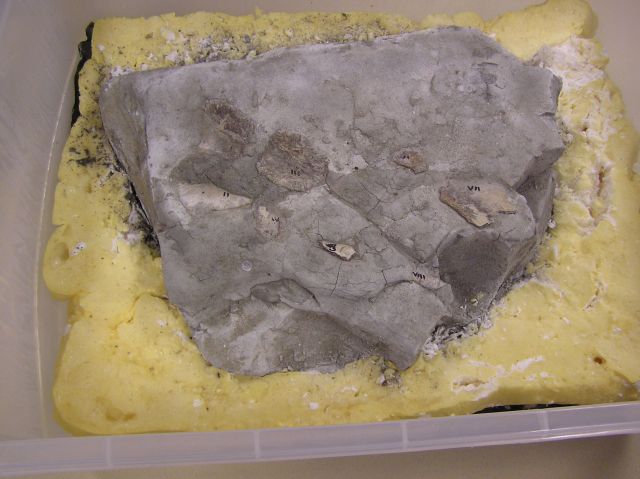
Turtle after preparation. Click image for a different view.

Anca is closely examining the limestone. She found a fish tooth in this area.
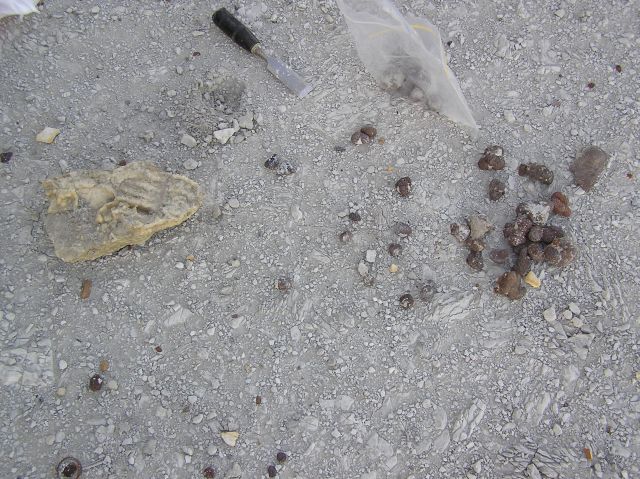
Another site further down the river where we collected marcasite.

Michael with some nice marcasite specimens. We discovered he is a marcasite specialist, and some of us discussed the need for a Coprolite Committee.

Claire also found a fantastic specimen of calcite, about the size of a fist.

View of the river.

We ended the day with more good conversation at a restaurant near the collecting site. Another "way out in the boonies" place with no advertising; if you don't know where it is, you probably won't even find it by accident.
April 23, 2005 - Cretaceous Fossils, Sumter Co, AL
Steve was spotted tooling around in the boat, looking as if he planned to go way down to a place that was difficult to walk to, so Vicki stuck out her thumb and she and Paige hitched a ride. A very exciting time getting into that boat from a cliff face! Claire decided not to try the boat trick, but decided to risk walking along the steep bluff. We got there about the same time, and of course were looking for "great treasures". Vicki spotted something that looked "odd" pretty quickly, and it turned out to be part of a large ammonite embedded in a huge boulder that everyone had walked past. We all started hunting around that area, but didn't find the other half. Further down, Steve stuck his hammer up under a rock before putting his hand there to check for fossils. Good thing he did, because a cottonmouth attacked the hammer! After moving away from the snake, we heard Claire squeal. She had found another large ammonite near where the first one was found, and it was almost complete. Steve just shook his head, and declared he would never pick up hitch-hikers again!
A small group took off on a scouting expedition after the trip was officially over. They found a nice shelf area with numerous fossils which were very fragile and easily breakable. So, we'll just enjoy the pictures! Found a number of very nice ammonites, a few shells, and pieces of fossil wood.
A big THANK YOU goes to Captain Gilbert and Captain Steve for the use of their boats!
(pictures courtesy Lea Martin, Claire Smith, and Vicki Lais.)

Hanging out waiting for everyone to arrive.

Paige, Leisa, Gilbert, Carl & Vicki popping out the small gastropods and straight cephalopods.

Claire is just getting started.

Mosasaur vertebra found by Vicki, quite a distance from the others that were found on the last trip.

Leisa excavating around a fragile fossil.

And the nice gastropod she collected.

The chalky shoreline. (Paige isn't tired, just getting a closer look!)

Steve's attention has just been diverted as someone stopped to talk . . .

Close-up of some of Steve's finds, mostly gastropods. There is also a nice mosasaur bone in that box.

Tiny nautiloid found by Steve.

Several Exogira were found.

Some of Lea's finds.

Some of Paige's finds.
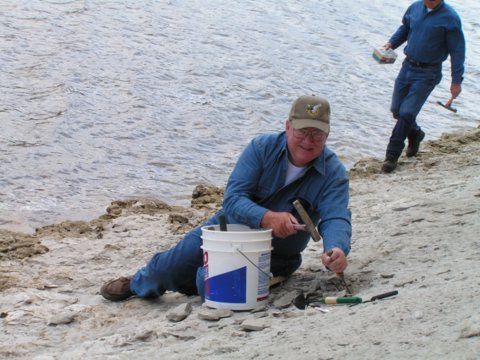
Gilbert has found another one (what, I don't know!)

Nice gastropod and the impression it left in the chalk, found by either Lea or Paige.

Nice partial ammonite in place. It really blends in with the boulder quite well. Several people passed by without spotting it, leaving it for Vicki to find!

Same ammonite after excavation. This is the bottom that was protected from weathering.

Paige holding an ammonite found by Claire.
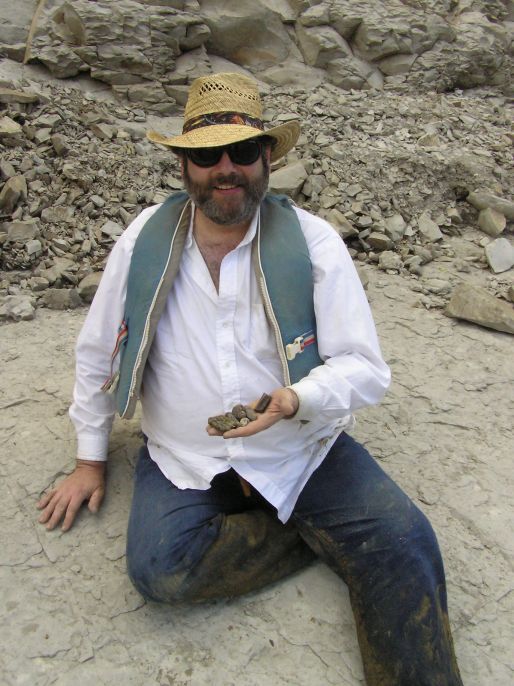
Carl showing off his favorite finds.

Captain Steve and Captain Gilbert. Thanks, guys!

Gilbert found some fossil carbonized wood and a mass of what is either worm tubes or bryozoans.

Another nice gastropod and image it left in the chalk.

Shells embedded in the chalk.

Carl & Leisa, tuckered out after a long day.

Steve's finds, all cleaned up and protective coating applied.

Nice Ammonite found by Claire (after cleaning)

Another view of the ammonite.

A limestone shelf filled with fossils found in the late evening. Nice to look at, but the fossils were too fragile to collect. Below is our "picture collection".

Nice ammonite.

A limb of carbonized wood.

Another nice ammonite.
















